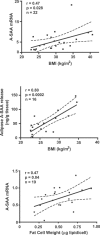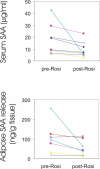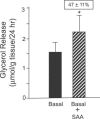Acute-phase serum amyloid A: an inflammatory adipokine and potential link between obesity and its metabolic complications
- PMID: 16737350
- PMCID: PMC1472697
- DOI: 10.1371/journal.pmed.0030287
Acute-phase serum amyloid A: an inflammatory adipokine and potential link between obesity and its metabolic complications
Abstract
Background: Obesity is associated with low-grade chronic inflammation, and serum markers of inflammation are independent risk factors for cardiovascular disease (CVD). However, the molecular and cellular mechanisms that link obesity to chronic inflammation and CVD are poorly understood.
Methods and findings: Acute-phase serum amyloid A (A-SAA) mRNA levels, and A-SAA adipose secretion and serum levels were measured in obese and nonobese individuals, obese participants who underwent weight-loss, and persons treated with the insulin sensitizer rosiglitazone. Inflammation-eliciting activity of A-SAA was investigated in human adipose stromal vascular cells, coronary vascular endothelial cells and a murine monocyte cell line. We demonstrate that A-SAA was highly and selectively expressed in human adipocytes. Moreover, A-SAA mRNA levels and A-SAA secretion from adipose tissue were significantly correlated with body mass index (r = 0.47; p = 0.028 and r = 0.80; p = 0.0002, respectively). Serum A-SAA levels decreased significantly after weight loss in obese participants (p = 0.006), as well as in those treated with rosiglitazone (p = 0.033). The magnitude of the improvement in insulin sensitivity after weight loss was significantly correlated with decreases in serum A-SAA (r = -0.74; p = 0.034). SAA treatment of vascular endothelial cells and monocytes markedly increased the production of inflammatory cytokines, e.g., interleukin (IL)-6, IL-8, tumor necrosis factor alpha, and monocyte chemoattractant protein-1. In addition, SAA increased basal lipolysis in adipose tissue culture by 47%.
Conclusions: A-SAA is a proinflammatory and lipolytic adipokine in humans. The increased expression of A-SAA by adipocytes in obesity suggests that it may play a critical role in local and systemic inflammation and free fatty acid production and could be a direct link between obesity and its comorbidities, such as insulin resistance and atherosclerosis. Accordingly, improvements in systemic inflammation and insulin resistance with weight loss and rosiglitazone therapy may in part be mediated by decreases in adipocyte A-SAA production.
Conflict of interest statement
Figures









References
-
- National Cholesterol Education Program (NCEP) Expert Panel on Detection, Evaluation, and Treatment of High Blood Cholesterol in Adults (Adult Treatment Panel III) Third Report of the National Cholesterol Education Program (NCEP) Expert Panel on Detection, Evaluation, and Treatment of High Blood Cholesterol in Adults (Adult Treatment Panel III) final report. Circulation. 2002;106:3143–3421. - PubMed
-
- Reaven GM. Role of insulin resistance in human disease (syndrome X): An expanded definition. Annu Rev Med. 1993;44:121–131. - PubMed
-
- Pearson TA, Mensah GA, Alexander RW, Anderson JL, Cannon RO, et al. Markers of inflammation and cardiovascular disease: Application to clinical and public health practice: A statement for healthcare professionals from the Centers for Disease Control and Prevention and the American Heart Association. Circulation. 2003;107:499–511. - PubMed
-
- Isomaa B, Almgren P, Tuomi T, Forsen B, Lahti K, et al. Cardiovascular morbidity and mortality associated with the metabolic syndrome. Diabetes Care. 2001;24:683–689. - PubMed
-
- Ridker PM, Hennekens CH, Buring JE, Rifai N. C-reactive protein and other markers of inflammation in the prediction of cardiovascular disease in women. N Engl J Med. 2000;342:836–843. - PubMed
Publication types
MeSH terms
Substances
Grants and funding
- R01 AG18408/AG/NIA NIH HHS/United States
- R01 AG018408/AG/NIA NIH HHS/United States
- R01 DK056637/DK/NIDDK NIH HHS/United States
- K01 AG00747/AG/NIA NIH HHS/United States
- M01 RR16500/RR/NCRR NIH HHS/United States
- R29 A614066/PHS HHS/United States
- R01 DK054261/DK/NIDDK NIH HHS/United States
- R01 DK052398/DK/NIDDK NIH HHS/United States
- R01 AG019310/AG/NIA NIH HHS/United States
- R01 DK56637/DK/NIDDK NIH HHS/United States
- M01 RR016500/RR/NCRR NIH HHS/United States
- DK62093/DK/NIDDK NIH HHS/United States
- R01 DK062093/DK/NIDDK NIH HHS/United States
- R01 DK54261/DK/NIDDK NIH HHS/United States
- T32 AG000219/AG/NIA NIH HHS/United States
- R01 DK52398/DK/NIDDK NIH HHS/United States
- Z01 AG000747/ImNIH/Intramural NIH HHS/United States
- R01 AG19310/AG/NIA NIH HHS/United States
- DK57835/DK/NIDDK NIH HHS/United States
LinkOut - more resources
Full Text Sources
Other Literature Sources
Medical
Research Materials
Miscellaneous

